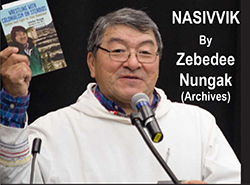
NASIVVIK By Zebedee Nungak,
Windspeaker Columnist; Archives 2003
Nasivvik is an Inuktitut word that means vantage point. It can be a height of land, a hummock of ice, or any place of elevation that affords observers a clear view of their surroundings to make good observations.
In photographs from long ago, Inuit appear as red-cheeked, fit and healthy-looking people. Inuit then were physically vigorous and always looked the part. In traditional times, the Arctic environment was a holistic, natural gymnasium, and every aspect of life was, of necessity, a physical workout. The staple foods derived from Arctic wildlife, abundant in nutritious vitamins, were complementary to a thoroughly active life.
Daily living in igloos and tents required constant motion as a matter of routine. Bending, stretching, jumping, running, and lifting were all as natural as breathing. Walking, then an unavoidable means of mobility, also enhanced fitness. The rhythms of life didn't leave much opportunity for any healthy person to be physically inactive. Water had to be hauled manually from sources, which could be quite a distance away. Fuel gathered on the tundra had to be carried good hiking distances on people's backs over rough and rocky terrain. Dogs had to be chased, harnessed, un-harnessed, and fed. Equipment had to be constantly maintained in top shape and properly stored, out of the reach of dogs.
Before mechanical means existed, traveling was, in every way, hard physical exercise. Every muscle in the body was used in the course of qimutsiq (dog-team) travel. Building overnight shelters and setting up camp was almost second nature physical reflexes. Upper body strength was finely honed by paddling a qayaq. "Communal Eskimo power" provided more than adequate brute force whenever a boat had to be launched or hauled up.
Each Inuit encampment had its athletic young people, who didn't need any prompting to start a game of ayuttaq (soccer), or pattaq (catch ball). Games requiring strength, agility, and manual dexterity were part of the order of life. It's no wonder, then, that some people were legends in their own time for being able to perform amazing feats of strength. Many people were incredibly strong.
In the present day, people in their prime don't even dare try to lift rocks, which used to be lifted and carried in contests of strength. Similarly, distances, which used to be run in races, have passed into legend.
Now, the term, "couch potato" is a fitting description of what has happened to the physical condition of Inuit, en masse, during the 40-plus years that we have become townspeople. Modern conveniences and the newfangled gadgets of civilization cannot come quickly enough to ease yet another aspect of a life, which now requires almost no physical exertion. We literally never sweat anymore in going about doing the things of daily life.
Modern living in a wooden house, with every comfort known to mankind, is now the definition of ease. Water and fuel are delivered, garbage and sewage hauled away, and electricity is provided, albeit at a cost. Labour-saving devices of every imagination have conquered us by stealth—electric can-openers, dishwashers, and microwaves. We need never move from the couches upon which we are "potatoes." To control sound systems and electronic gadgetry we have a remote control device.
The little muscle power that used to be required to pull the starter of a snowmobile or ATV is surrendering without a fight to touch-button electric convenience. Everybody has become spoiled beyond redemption by the conveniences of motorized mobility.
Health awareness programs wage a losing battle in efforts to encourage people to eat healthy, country food from the land and sea. If we are what we eat, a generation of Inuit could now be described as walking chicken legs, pork chops, and fast, pre-packaged, factory-processed 'junk' food! Physical exercise may not yet be obsolete, but is now quite uncommon. With an over-abundance of things to munch on, we are traveling down the fast track to mass obesity.
There was a time within memory when it was mainly the Qallunaat (white people) who possessed the physical characteristic of being pot-bellied, a condition known as naaqqaluk and naraaji in the two main dialects of Inuktitut in Nunavik. Now, this condition exists among a great many Inuit, and naaqqaluit-naaraajiit are nothing unusual.
Physical vigor, muscular strength, and running strength are not very common among Inuit any more. Sedentary, civilized life is a natural pull toward laziness. The comforts of the couch force a lot of internal "cranking up" before we act on something as freely available as regular walking. It's going to take premeditated effort to shake off the "Couch Potato Syndrome" and to arrest this downward slide in bodily fitness among Inuit.
The physical vigor and bodily fitness, formerly characteristic of Inuit, can be spoken of in the past tense, which is a pity. Fortunately, we don't have to dig far into our collective psyche to rediscover the desire to be fit. Reclaiming physical fitness is still entirely possible, if we first recognize what has caused our slide down this slope.
